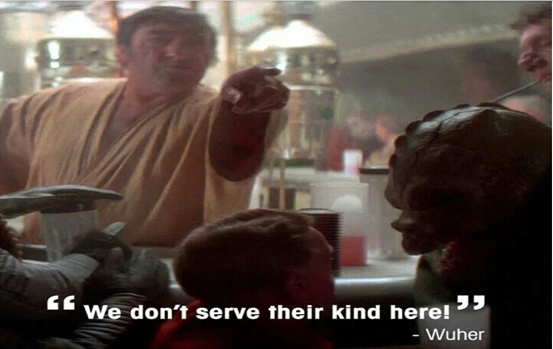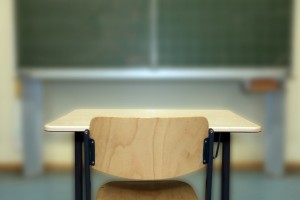The television classic “King of the Hill” included a character known as Dale, who despite being a conspiracy theorist is entirely oblivious to the fact that that his wife is carrying on a long-term affair. Dale holds forth on multiple elaborate conspiracies, often of the “birds aren’t real” level of absurdity. Dale’s wife, however, claims to have suffered from “migraines” for years, and Dale’s “son” happens to strongly resemble his wife’s “therapeutic masseur,” John Redcorn. ProPublica may have taken inspiration from Dale for a series of reports about “segregation academies” in (so far) North Carolina and Mississippi.
In the case of North Carolina, the ProPublica team raised concerns over a number of private school segregation academies with 85% or more from the same racial or ethnic group. However, they failed to notice that the number of public schools with 85% or more students from the same racial/ethnic group was much higher. Moreover, the total number of students and money going to public school “segregation academies” dwarfed not only the number going to segregated private schools, but it easily dwarfed the number of students and money in the entirety of North Carolina’s voucher program.
Not satisfied with this level of Gribble, one of the Pro-Publica authors doubled down on Gribble and wrote a similar story about Mississippi:
In Mississippi, we identified 20 schools that likely opened as segregation academies and have received almost $10 million over the past six years from the state’s tax credit donation program.
Mississippi has two small scholarship programs for students with disabilities and a small ESA program for students with disabilities. In 2024, a combined 628 students participated across all three programs, all of whom were students with disabilities.
Meanwhile, in the Mississippi public school system, data from the National Center for Education Statistics shows 56 Mississippi public schools with a student body that is 85% or more white, and 245 Mississippi public schools with a student body 85% or more Black. A total of 114,203 Mississippi students attend these highly segregated public schools, which represents 26% of the total public-school enrollment for the state.
Using my advanced Texas public school math skills, this works out to a great deal more money than $10 million over six years. So, let’s see, approximately $5.4 billion public school budget in Mississippi in 2022, 26% of the kids, approximately $1.4 billion annually, carry the two…right. Let’s call this somewhere around $8,000,000,000 that Mississippi taxpayers have spent sending kids to public school segregation academies over the same six-year period. Give or take a few hundred million as a rounding error. So, let’s put Mississippi spending on public school segregation academies somewhere on the order of 800 to 1, if ProPublica has their facts straight about the 20 private schools.
Before you unsheathe your flaming sword of justice and point it at Mississippi, you might want to run these numbers for your own state. Mississippi is still using ZIP code assignments to put the vast majority of students in schools. Housing tends to be very segregated, and ZIP code assignment leads to very segregated schools both by income and by race. Your state probably does the same, especially if you work for ProPublica.
The Stanford Educational Opportunity Project created a data set on school segregation, and let’s just put it out there on the record that Mississippi does not have the most segregated public school system. In this graphic, darker green equates to higher levels of segregation in 2022:
The most segregated school system in America is not in the South at all; that status is held by New York — in fact this was a status New York held continuously from 1991 to 2022 — the entirety of data collected by the Stanford project.
I’ll give you one guess as to which state Dale Gribble…errr…I mean ProPublica is headquartered. What’s that? New York is correct! Mississippi should give families more choices and abolish ZIP code assignment in schools, but New York needs it even worse than Mississippi. If ProPublica wants to address segregation in schools, they should start at home and with the public schools.

Available to All has released a new study called The Broken Promise of Brown v Board of Ed A 50-State Report on Legal Discrimination in Public School Admissions. This May will mark the 70th anniversary of Brown vs. Board, the landmark United States Supreme Court case which struck down segregating schools by race.

Linda Brown, whose family was among the plaintiffs in Brown v. Board of Education
Many decades later, all is not well:
Seven decades after Brown, low-income children—many of them children of color—are still systematically excluded from the very best public schools. The brutal truth is this: In 2024, Linda Brown wouldnʼt be turned away from a coveted public school because of her race, but itʼs likely she would still be turned away. And itʼs all perfectly legal.
The study details how district boundaries deny opportunities to attend high demand public schools, and the relative strengths and (mostly) weaknesses of district open enrollment in all 50 states. The state of district open enrollment is not pretty, and amazingly many public magnet schools seem even worse:
Believe it or not, many coveted magnet schools give enrollment preferences to wealthy families, trying to lure them away from their high-quality zoned schools. It is one of the great ironies of public education that magnet schools, created to reduce segregation and increase opportunities for low-income children of color, often now intentionally put those same children at a disadvantage. Linda Brown, in other words, might be legally turned away from a public school in 2024 because her family doesnʼt make enough money.
The study contains a how-to manual for improving open enrollment laws in the states- and there is a huge amount of room for improvement even in what we think of as relatively open enrollment friendly states. Many states for example still grant by statute a veto over to open-enrollment transfers to resident districts as if students were feudal serfs.
The study is well worth your time to examine, and I will only add that the incentives faced by districts are probably at least as important as the laws governing them. As Clayton Christensen noted, organizations cannot disrupt themselves, so laws allowing educators to open new private and public schools can create incentives for high-demand district schools to lower their drawbridges.

Students at Charter Day School, which in 2021 changed the name of its network to Classical Charter Schools of America.
Charter schools are still public schools, at least for now.
The U.S. Supreme Court announced Monday that it would not hear Charter Day School, Inc. v. Peltier, a closely watched case involving a North Carolina charter school’s dress code but that could have had broader implications for charter schools.
A group of female students sued Charter Day School, arguing its skirts-only dress code rule violated the Constitution. Their case hinged on whether the school was public or private under North Carolina law. Charter Day School had argued that charter schools, which receive government money but are privately managed, are essentially private and therefore not subject to the Constitution’s Equal Protection clause.
The high court’s decision to turn away the case came after the U.S. solicitor general for the Biden administrator advised the court not to hear the case and said that the U.S. 4th Circuit Court of Appeals 10-6 decision in favor the plaintiff was correct and that the case was not “a good vehicle for considering the question presented.”
The question it referred to centers on the status of charter schools. A ruling that affirmed Charter Day School’s assertion that such schools are private could have opened the door to faith-based charter schools that would not be bound by federal anti-discrimination laws.
Another test case could come from Oklahoma, which last month approved an application for the nation’s first religious charter school. The state’s Catholic church leadership have said St. Isidore of Seville Catholic Virtual Charter School would enable them to better serve students in rural areas without access to traditional Catholic schools and that charter status would allow it to serve families of all incomes as well as provide services for students with special needs.
Opponents argued that allowing the school violated the constitutional separation of church and state.
The application, which the Oklahoma Stateside Virtual Charter School Board approved on a 3-2 vote, has been mired in controversy, with advocates on both sides threatening a legal challenge depending on the outcome.
Brett Farley, a spokesperson for the Catholic Conference of Oklahoma, responded to the high court’s decision not to take up the North Carolina case, saying that any ruling it would have issued likely would have been limited to North Carolina.
“While it's a surprise, this case was not an ideal vehicle to resolve the question precisely because it's one can only be resolved state by state given that there are 45 unique charter regimes,” he said. “What may be true in North Carolina, therefore, isn't necessarily true for Oklahoma or for other charter states.”
However, a national charter school advocacy group, which opposed the Oklahoma charter application, praised the Supreme Court’s decision as confirmation that charter schools are public.
“We are pleased to put this matter behind us and move forward with the critically important work of ensuring every child in this nation has access to a high-quality public education,” said Nina Rees, president and chief executive officer of the National Alliance of Public Charter Schools. “The actions of the high court affirm that as public-school students, charter school students are entitled to the same federal protections as their counterparts who attend district schools."

The legendary Jack Coons of Berkeley writes, "One of the primary effects of this exclusion of God is that the school must now present some picture of human happiness and its achievement that fades with death; and that picture must be consistent with a reason for good citizen behavior."
Three score years ago the U.S. Supreme Court forbade the teaching and symbols of religion in public schools. God is neither to be discussed, pictured nor even sung to at Christmas; maybe at graduations and football games students may express their thanks to God – up to a point.
It is proper, of course, for the teachers to relate the truths of Darwin and his theory of natural selection. But, it is improper to invite the student mind to wonder about just how all that material reality came to be in the first place. Could matter create itself; could all this something come from nothing?
Q: Teacher, would you explain?
A: School doesn’t teach about that; ask your mother.
The social effect of banishing God-talk from the classroom is very difficult to estimate using the statistical lenses of social science. But, with observation and common sense, one can hope broadly to describe the expectations of the justices and, then, the degree of their realization in our time. The court hoped: 1) to clarify that using the public education office to make children aware of our God debates (or, worse, of course, to take sides) occasions an “establishment of religion,” hence is forbidden; and 2) thereby to assure an atmosphere in public school purged of transcendental ideology, assuring offense to none and, instead, making a contribution to social unity.
The court’s first hope appears realized to a considerable degree. Litigation and administrative persuasion have been successful at eliminating many books and teaching materials that suggest the existence of God and his role in human life. There is, I believe, little of the transcendental left lurking in our curricula. The court’s purge has, of course, been greatly assisted by many state constitutions that, since the late 19th Century, have forbidden nearly all public assistance to religious private schools.
One of the primary effects of this exclusion of God is that the school must now present some picture of human happiness and its achievement that fades with death; and that picture must be consistent with a reason for good citizen behavior. Even without God we have to live together. With eternal salvation as a classroom no-no, the government must present a life-plan and defend it. And so it does. With God out of the picture, each of us is “to find ourselves,” set our own goals and do what’s best for number one. To teach the child otherwise – to recognize and honor an already established human rule and responsibility – would verge upon theology. Of course, the teacher and the system do have rules of conduct for the child, but these must be understood and defended principally as the assurance that everyone, to a point, lets the other fellow do his own thing.
Has secularization worked? I fear not. (more…)
Today is back-to-school day for most school districts in Florida. But for the Plucinski family of Central Florida, it’s back to schools. And not just district schools.
Sisters Cora and Zuri will board a school bus to start the day at a district elementary school, while mom Corin Plucinski will drive brothers Zach and Nathan 30 minutes to a private school. They attend with help from one of Florida’s multiple educational choice scholarships.
In many parts of the country, this may be unusual. But in Florida, which offers one of the robust arrays of school choice in the country, it’s increasingly common. Growing numbers of families have different children attending different schools in different educational sectors.
To the Plucinskis, whose oldest is now headed to college after graduating from a district high school, there’s nothing odd about it.
“When you’ve got five kids you’re always juggling something anyway,” Corin Plucinski said.
Thirty years ago, roughly 90 percent of Florida students in preK-12 attended assigned district schools, and about 10 percent attended private schools. Beyond a handful of magnet schools, there was no state-supported school choice.
Fast forward a generation. Today, 46 percent of Florida students – 1.7 million – attend something other than their assigned district schools. About 300,000 attend charter schools. Another 300,000 attend private schools. Most of the rest attend options created by school districts, from magnet schools and career academies to IB and dual enrollment programs.
This flourishing landscape gives parents more opportunities to find the right fit for their kids. And for many families, that means one child in this sector, another in that sector. (more…)

The nation's first voucher for public school students struggling with reading opens for applications Monday
Starting Monday, Florida families can apply for the first voucher in the nation aimed at helping public elementary school students who struggle with reading. Already, more than 2,400 have signed up on an interest list.
Step Up For Students, a nonprofit that publishes this blog, is the only state-approved scholarship organization that has chosen to administer the program. After conducting a beta test last week, Step Up is turning on its online application for all comers on Monday. Families can apply through the homepage.
The scholarship program is fueled by a longstanding academic concern: Students who can’t read by the end of third grade face major hurdles in their academic success, according to educators and studies. The Children’s Reading Foundation, a national nonprofit that includes community-based reading chapters, estimates that 74 percent of such struggling readers will not be able to catch up.
In Florida this past year, 44 percent of third- and fourth-grade students – a total of 191,220 – failed to pass the state English Language Arts Assessment.
The Reading Scholarship Account, approved by the State Legislature this spring, gives parents access to an account worth $500 to pay for fees and tuition related to part-time tutoring, summer and after school literacy programs, reading curriculum and instructional materials.
The first-year appropriation is $9.7 million, which can serve more than 19,000 students. The scholarships are awarded on a first-come first-served basis.
To qualify for the scholarship, a student must be in third through fifth grade, enrolled in a Florida public school, and have scored below a Level 3 on the English Language Arts assessment this past spring. Priority under the law is given to students who are designated as “English Language Learners.”
A growing list of community groups and school districts have inquired about providing reading services to scholarship students, and the law requires that individuals wanting to offer part-time tutoring services must hold a valid teaching certificate.
A 2014 MRDC study of a multi-state reading tutor program showed promising results for struggling students. MRDC found that, after only one year, the “Reading Partners” program helped students in second-to-fifth grades improve in three different measures of reading proficiency.
 Wayne Au, University of Washington at Bothell
Wayne Au, University of Washington at BothellWayne Au, an education professor and plaintiff in League of Women Voters v. State (the case that found charter schools unconstitutional in Washington) claims charter schools aren’t public schools.
Au’s actually conflating the word “public school” with the concept of the “common school,” a 19th-century form of public-education that doesn't apply to all 21st-century public schools.
Au concludes: “If a school is not controlled by a public body, then it should not have access to public funds.” First, the elected school board of Spokane, WA approved a charter school, and that was overturned by the Supreme Court too — an inconvenient fact neither Au nor the state Supreme Court has bothered to address.
Second, not every public education institution is subject to direct, democratic control. Even the University of Washington, which employs Au, is governed by unelected appointees, yet is financed in part by the same public funds charter schools are now prohibited from touching.
“Public schools” have been defined by how they’re financed (public support through taxation) and the purpose they serve (educating the public) — not the specific method of governance. Yes, charter schools are public schools.
 Rex Sinquefield and the Children’s Education Alliance
Rex Sinquefield and the Children’s Education AllianceProgressives in Missouri criticized Rex Sinquefield for conspiracy theories about public schools, spending millions on campaigns supporting private school choice and for donations to ALEC, but they remain oddly silent about the way he, and the organizations he backs, are spending money right now.
Before we discuss these latest expenditures, a little history is in order.
Last year, over 1,000 students (about one of every four) in the mostly low-income, minority Normandy School District transferred out thanks to a law that allowed students in low-performing districts to enroll in higher-performing districts. As a result of all the transfers, Normandy faced bankruptcy and was taken over by the state. The Missouri Board of Education voided the district’s low-performing status and revoked the right to transfer. Fortunately, a judge recently overturned the Board’s new rule.

Normandy students
Now Normandy must allow students to transfer and every district, except for the mostly white and affluent Francis-Howell School District, agreed to comply. Francis-Howell said they would only accept transfer students upon direct court order.
In other words, officials in the mostly white affluent district told low-income minority parents they needed to hire a lawyer if they wanted their child enrolled. Fortunately, Rex Sinquefield’s Children’s Education Alliance is covering the legal expenses of any Normandy parent who wants to do that.
So far, the attorney for the alliance has enrolled 17 students in Francis-Howell and is requesting court orders for another 35. Francis-Howell, meanwhile, has spent $17,000 trying to keep the students out.
 Florida won’t pay a school to NOT educate a student. I’ll put that another way: the state doesn’t pay for students to not attend a school.
Florida won’t pay a school to NOT educate a student. I’ll put that another way: the state doesn’t pay for students to not attend a school.
It is a simple and intuitive fact, yet some Floridians – many happen to be parental choice critics – don’t seem to get it.
For 41 years, the Florida Legislature has funded education with a formula based specifically on the cost to educate each student. The just-approved 2014-15 spending plan is no different: It determines the average student will cost $6,937 to educate, multiplies that amount by a projected enrollment of 2,722,134 and arrives at a bottom line of $18.9 billion. Each district is paid accordingly.
Not surprisingly, this means the state won’t pay a school for students educated somewhere else. But look at the responses from Floridians concerned about the newer private options available to lower-income and special needs students:
(As we always note, the scholarship program is administered by Step Up For Students, which co-hosts this blog.)
Opposing one type of school choice program because it “diverted” money, takes “tax dollars out,” or leaves public schools with “fewer resources” requires critics to ignore the state’s method of funding K-12 education. (more…)